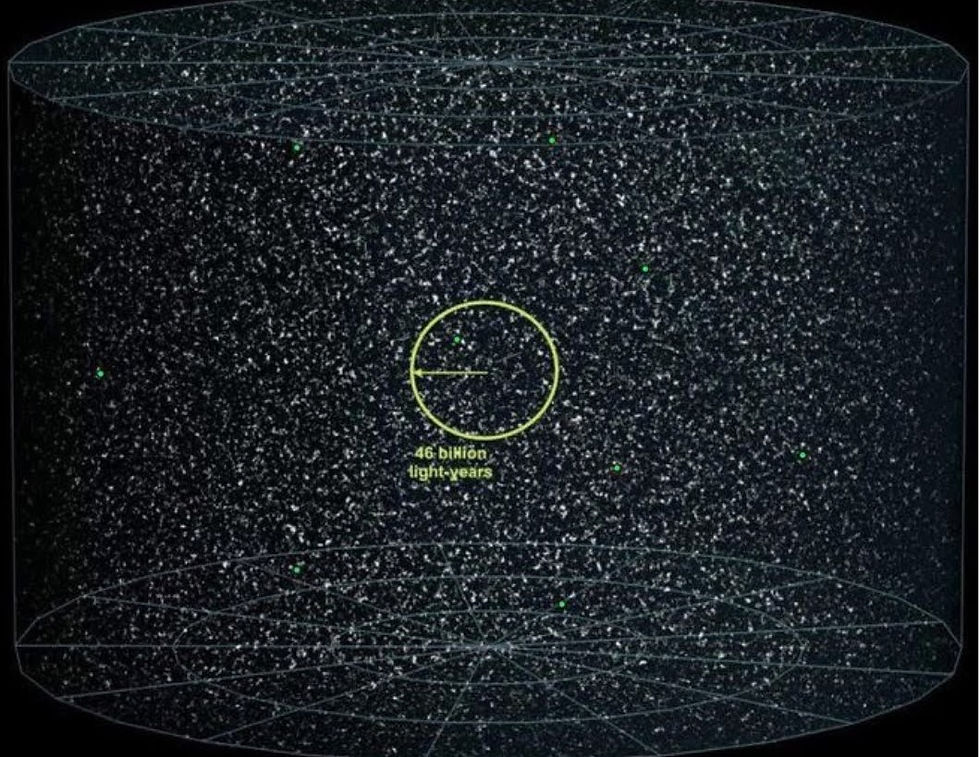Cosmology is a Paradox
- Lindsay Fraser Forbes

- Oct 20, 2020
- 4 min read
Cosmology is a Paradox
We see so much; we see so little.
We know so much; we know so little.
Cosmology:
“the scientific study of the origin, evolution, and eventual fate of the universe” Wikipedia.
1. Origin - It tells us nothing about where all the stuff of the universe came from.
2. Evolution - It leaves 95% of our universe unexplained.
3. Fate - It tells us little about how the universe will end.
Yet, we know so much. The Big Bang theory is an amazing and successful explanation of what has happened in our universe over the last 13.8 billion years. Nucleosynthesis, the calculation of how the first elements were formed. CMB, the detection and analysis of the Cosmic Microwave Background. The formation of stars and galaxies. The list goes on and on.
But, we know so little. Big Bang theory and LCDM cannot explain the origin, evolution and fate of the universe. Sure there are lots of theories, but even the best of them look pretty thin. We can measure the expansion of the universe but we have no idea what is doing it.
Where did all the stuff of the universe come from? That's billions of stars in trillions of galaxies and add in all the dust, black holes and then take that x6 for Dark Matter. When cosmology is struggling for an explanation it often turns to quantum mechanics. Now QM and GR are powerful tools in themselves, but they make bad partners. We are asked to accept that some quantum imbalance in the order of 10 billion to 1 in matter over antimatter explains where all the atoms and Dark Matter came from. Even worse, the error in the calculation of the vacuum energy is 10^120, the so-called quantum catastrophe, but we will get to Dark Energy later.
To be fair, most cosmologists do admit to the fact that we have no idea where it all came from. Add to that the 95% of the universe that is known by the placeholders, Dark Energy and Dark Matter. It is reasonable to say that we know so little.
We see so much; we see so little.
Let's leave the theorists to their maths and give respect to the real workhorses of astronomy. In the last 100 years there have been so many amazing developments in technology.
It is exactly 100 years since the great debate between Shapley and Curtis - how big was the universe? Was it just the Milky Way, or was there more out there?
Young Shapley believed that “spiral nebulae” like Andromeda were part of the Milky Way. To regard them as anything more was to admit the cosmos was larger than most astronomers in the early 20th century were willing to accept. Later that decade, Edwin Hubble’s measurements of Cepheid variable stars proved that Andromeda did indeed lie outside the Milky Way, forever changing our understanding of the scale of the universe. The distance measurement to Andromeda was the most significant game changer since the work of Copernicus/Galileo. Hubble effectively discovered the universe.
Today we have massive telescopes on the ground and in the sky. We ‘look’ at the sky not just with visible light but across the full range of the electromagnetic spectrum. We can even ‘listen’ to the universe with those fantastic gravitational wave detectors.
As a result we can measure the size of our observable universe and count the number of stars and galaxies. We know that black holes exist; we can measure their mass; we can image them; we can even listen to them colliding.
Although we can see so much, there is so much we cannot see.
The problem is the speed of light. We can never see what is happening now. The farther out you look the worse it gets. It’s not a problem close by. We have only to wait 499 seconds to get the light from the sun. We have to remind ourselves when we wait and watch to see if Betelgeuse is, or is not, going to explode that what we actually watching happened 642 years ago. If you are studying the evolution of stars and galaxies it can be an advantage to be able to see into the past.
If however you are studying the evolution of the universe you can only see what happened in the past. If you want to know what the universe looks like today, then you have to model it. The bits you can study best are the bits closest to us, but their movements are affected by the mutual gravities of our local group of galaxies and beyond that into the Virgo Supercluster and beyond to the Laniakea Supercluster. Although 500 million light years across it's tiny compared to the observable universe at 93 billion light years.
93 billion light years is just the bit we can see. The universe is much bigger than that. We just can't see it.

There is so much we cannot see.
Once again it is reasonable to say that we see so little.
Ethan Seagal, Forbes




































Comments